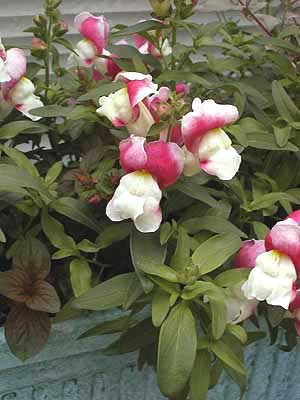Antirrhinum 'Floral Showers'
SNAPDRAGON
Family: Scrophulariaceae
Pronounced: an-tih-RI-num MAY-jus
Quick Jumps
Growing Guide
Rainy Side Notes
GROWING GUIDE

Origin:
Garden.
Plant Group:
Short-lived perennial, usually grown as an annual.
Hardiness:
Sunset zones: A1, A3; 1-24.
USDA zones: down to 5 when grown as an annual; winter hardy in zones 7-10.
Mature size:
Height: 8 inches (20 cm).
Flowering period:
Late spring through summer. It sometimes flowers during our mild winters.
Flowering attributes:
Racemes of coral-pink and cream petals.
Leaf attributes:
Lance-shaped, deep green, glossy leaves.
Light:
Full sun.
Soil:
Moist, humus rich, well-drained soil.
Feeding:
Use a complete organic fertilizer when planting. If the plants winter over, side dress with fertilizer and compost in spring.
Propagation Methods:
Sow seed in winter at 61-64°F (16-18°C).
Pruning Methods:
Deadhead flowers to prolong blooming.
Pests and Diseases:
Rust and botrytis may be problematic. Aphids, spider mites and caterpillars may be troublesome. None have caused problems in my garden.
Rainy Side Notes
Although most references recommend full sun, mine grow in partial shade on the east side of the house. This small little snapdragon does very well in containers or in the front of a border.
Snapdragons are an old-fashioned plant commonly grown in cottage gardens. They probably were one of our grandmother's favorite flowers. As a child, I remember squeezing the sides of the blossom to make the flower open up like a mouth. I watched the bumblebees land on the flower, force open the blossom, and disappear inside the flower. Sometimes I dare to tickle the flower while the bumblebee is inside, busy collecting nectar. Snapdragons are not only beautiful; they sometimes bring out the child in us.
For the vase, cut flowers when about 1/3 of the flowers are open or approximately eight flowers. Flowers persist 5-8 days in water.
All parts of the plant are poisonous; do not ingest!
Debbie Teashon
Photographed in author's garden.

Gardening for the Homebrewer: Grow and Process Plants for Making Beer, Wine, Gruit, Cider, Perry, and More
By co-authors Debbie Teashon (Rainy Side Gardeners) and Wendy Tweton
Copyright Notice | Home | Search | Annuals

